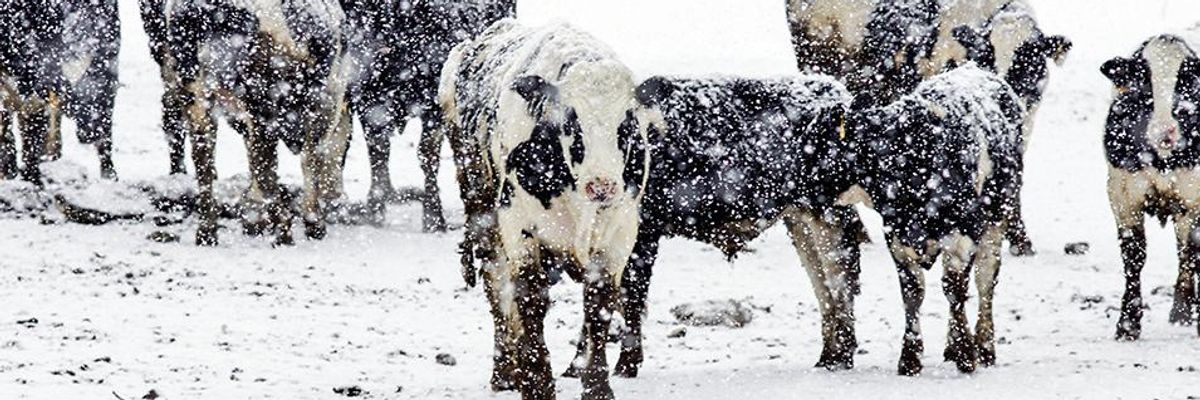
As "freak" weather events become the new norm, farmers and ranchers must take the necessary precautions to protect their animals from cold-weather-related injuries and illnesses. (Lorianne Ende/Getty)
Monster Storms Can Spell Disaster for Farm Animals
Before a severe weather event, producers must provide extra feed and adequate shelter to their animals, monitor water and heat sources, and develop an evacuation plan.
A massive late-winter blizzard walloped the Rockies and the Great Plains over the weekend before taking aim at the Midwest. Meanwhile, Texans were still cleaning up tornado damage after multiple tornados touched down Saturday, just one month after Winter Storm Uri killed dozens of residents and left millions without power for days. While most Americans understandably focus their attention on the human toll from these devastating storms, we cannot forget the hundreds of thousands of farm animals (along with an untold number of fish and wildlife species) who have suffered egregiously and lost their lives to the freeze.
Across the South, calves reportedly froze to death after being buried under the snow. Cattle and horses fell through the ice of stock tanks and drowned. Sanderson Farms, one of the country's largest poultry companies headquartered in Laurel, MS, reported the loss of 455,000 chickens who either froze to death due to power outages, were crushed by the roof of barns that caved in under the weight of snow and ice, or otherwise died from lack of food or water. The company also reported euthanizing more than half a million chicks at their hatcheries across Texas, after the animals could not be transported to contract producers.
Industry experts are still gathering information to determine just how many cows, sheep, goats, and poultry were killed in the historic storm, but agricultural economists at Texas A&M AgriLife Extension Service estimate that the livestock sector in Texas alone sustained at least $228 million in losses -- a number that is expected only to rise.
Taxpayers will likely be responsible for bankrolling a significant portion of those losses under disaster assistance programs administered by the U.S. Department of Agriculture. While a portion of these payments could assist producers who took quick action to care for their animals in extreme weather, these programs lack the necessary controls to ensure that all recipients are proactive in their disaster planning.
According to federal spending data, from 2008 to 2020 more than $473 million has been paid out under the USDA's Livestock Indemnity Program, which subsidizes producers for higher-than-normal livestock losses caused by adverse weather.
Winter Storm Uri was considered unprecedented, but communities across the country are increasingly pummeled by weather disasters fueled by climate change. In late 2015, for instance, a blizzard (viewed as an anomaly at the time) claimed the lives of at least 35,000 cattle in Texas and New Mexico. In 2018, more than 100 people and at least 5.5 million pigs and poultry perished in North Carolina in the aftermath of hurricanes Florence and Michael. Last year, wildfires ravaged the West Coast, only to be followed by a record-breaking hurricane season on the East Coast.
As these "freak" weather events become the new norm, farmers and ranchers must take the necessary precautions to protect their animals from cold-weather-related injuries and illnesses. When subjected to extremely cold conditions, farm animals can suffer from hypothermia and frostbite and may be vulnerable to other illnesses as a result of a weakened immune system. Newborns and younger animals, as well as animals with pre-existing conditions, are especially susceptible to hypothermia because their bodies have lower energy reserves that prevent them from producing enough body heat.
Before a severe weather event, producers must provide extra feed and adequate shelter to their animals, monitor water and heat sources, and develop an evacuation plan, among other preparations. These steps will not only save lives, but also assure taxpayers that they are no longer subsidizing a multibillion-dollar industry for its lack of foresight.
An Urgent Message From Our Co-Founder
Dear Common Dreams reader, The U.S. is on a fast track to authoritarianism like nothing I've ever seen. Meanwhile, corporate news outlets are utterly capitulating to Trump, twisting their coverage to avoid drawing his ire while lining up to stuff cash in his pockets. That's why I believe that Common Dreams is doing the best and most consequential reporting that we've ever done. Our small but mighty team is a progressive reporting powerhouse, covering the news every day that the corporate media never will. Our mission has always been simple: To inform. To inspire. And to ignite change for the common good. Now here's the key piece that I want all our readers to understand: None of this would be possible without your financial support. That's not just some fundraising cliche. It's the absolute and literal truth. We don't accept corporate advertising and never will. We don't have a paywall because we don't think people should be blocked from critical news based on their ability to pay. Everything we do is funded by the donations of readers like you. Will you donate now to help power the nonprofit, independent reporting of Common Dreams? Thank you for being a vital member of our community. Together, we can keep independent journalism alive when it’s needed most. - Craig Brown, Co-founder |
A massive late-winter blizzard walloped the Rockies and the Great Plains over the weekend before taking aim at the Midwest. Meanwhile, Texans were still cleaning up tornado damage after multiple tornados touched down Saturday, just one month after Winter Storm Uri killed dozens of residents and left millions without power for days. While most Americans understandably focus their attention on the human toll from these devastating storms, we cannot forget the hundreds of thousands of farm animals (along with an untold number of fish and wildlife species) who have suffered egregiously and lost their lives to the freeze.
Across the South, calves reportedly froze to death after being buried under the snow. Cattle and horses fell through the ice of stock tanks and drowned. Sanderson Farms, one of the country's largest poultry companies headquartered in Laurel, MS, reported the loss of 455,000 chickens who either froze to death due to power outages, were crushed by the roof of barns that caved in under the weight of snow and ice, or otherwise died from lack of food or water. The company also reported euthanizing more than half a million chicks at their hatcheries across Texas, after the animals could not be transported to contract producers.
Industry experts are still gathering information to determine just how many cows, sheep, goats, and poultry were killed in the historic storm, but agricultural economists at Texas A&M AgriLife Extension Service estimate that the livestock sector in Texas alone sustained at least $228 million in losses -- a number that is expected only to rise.
Taxpayers will likely be responsible for bankrolling a significant portion of those losses under disaster assistance programs administered by the U.S. Department of Agriculture. While a portion of these payments could assist producers who took quick action to care for their animals in extreme weather, these programs lack the necessary controls to ensure that all recipients are proactive in their disaster planning.
According to federal spending data, from 2008 to 2020 more than $473 million has been paid out under the USDA's Livestock Indemnity Program, which subsidizes producers for higher-than-normal livestock losses caused by adverse weather.
Winter Storm Uri was considered unprecedented, but communities across the country are increasingly pummeled by weather disasters fueled by climate change. In late 2015, for instance, a blizzard (viewed as an anomaly at the time) claimed the lives of at least 35,000 cattle in Texas and New Mexico. In 2018, more than 100 people and at least 5.5 million pigs and poultry perished in North Carolina in the aftermath of hurricanes Florence and Michael. Last year, wildfires ravaged the West Coast, only to be followed by a record-breaking hurricane season on the East Coast.
As these "freak" weather events become the new norm, farmers and ranchers must take the necessary precautions to protect their animals from cold-weather-related injuries and illnesses. When subjected to extremely cold conditions, farm animals can suffer from hypothermia and frostbite and may be vulnerable to other illnesses as a result of a weakened immune system. Newborns and younger animals, as well as animals with pre-existing conditions, are especially susceptible to hypothermia because their bodies have lower energy reserves that prevent them from producing enough body heat.
Before a severe weather event, producers must provide extra feed and adequate shelter to their animals, monitor water and heat sources, and develop an evacuation plan, among other preparations. These steps will not only save lives, but also assure taxpayers that they are no longer subsidizing a multibillion-dollar industry for its lack of foresight.
A massive late-winter blizzard walloped the Rockies and the Great Plains over the weekend before taking aim at the Midwest. Meanwhile, Texans were still cleaning up tornado damage after multiple tornados touched down Saturday, just one month after Winter Storm Uri killed dozens of residents and left millions without power for days. While most Americans understandably focus their attention on the human toll from these devastating storms, we cannot forget the hundreds of thousands of farm animals (along with an untold number of fish and wildlife species) who have suffered egregiously and lost their lives to the freeze.
Across the South, calves reportedly froze to death after being buried under the snow. Cattle and horses fell through the ice of stock tanks and drowned. Sanderson Farms, one of the country's largest poultry companies headquartered in Laurel, MS, reported the loss of 455,000 chickens who either froze to death due to power outages, were crushed by the roof of barns that caved in under the weight of snow and ice, or otherwise died from lack of food or water. The company also reported euthanizing more than half a million chicks at their hatcheries across Texas, after the animals could not be transported to contract producers.
Industry experts are still gathering information to determine just how many cows, sheep, goats, and poultry were killed in the historic storm, but agricultural economists at Texas A&M AgriLife Extension Service estimate that the livestock sector in Texas alone sustained at least $228 million in losses -- a number that is expected only to rise.
Taxpayers will likely be responsible for bankrolling a significant portion of those losses under disaster assistance programs administered by the U.S. Department of Agriculture. While a portion of these payments could assist producers who took quick action to care for their animals in extreme weather, these programs lack the necessary controls to ensure that all recipients are proactive in their disaster planning.
According to federal spending data, from 2008 to 2020 more than $473 million has been paid out under the USDA's Livestock Indemnity Program, which subsidizes producers for higher-than-normal livestock losses caused by adverse weather.
Winter Storm Uri was considered unprecedented, but communities across the country are increasingly pummeled by weather disasters fueled by climate change. In late 2015, for instance, a blizzard (viewed as an anomaly at the time) claimed the lives of at least 35,000 cattle in Texas and New Mexico. In 2018, more than 100 people and at least 5.5 million pigs and poultry perished in North Carolina in the aftermath of hurricanes Florence and Michael. Last year, wildfires ravaged the West Coast, only to be followed by a record-breaking hurricane season on the East Coast.
As these "freak" weather events become the new norm, farmers and ranchers must take the necessary precautions to protect their animals from cold-weather-related injuries and illnesses. When subjected to extremely cold conditions, farm animals can suffer from hypothermia and frostbite and may be vulnerable to other illnesses as a result of a weakened immune system. Newborns and younger animals, as well as animals with pre-existing conditions, are especially susceptible to hypothermia because their bodies have lower energy reserves that prevent them from producing enough body heat.
Before a severe weather event, producers must provide extra feed and adequate shelter to their animals, monitor water and heat sources, and develop an evacuation plan, among other preparations. These steps will not only save lives, but also assure taxpayers that they are no longer subsidizing a multibillion-dollar industry for its lack of foresight.

